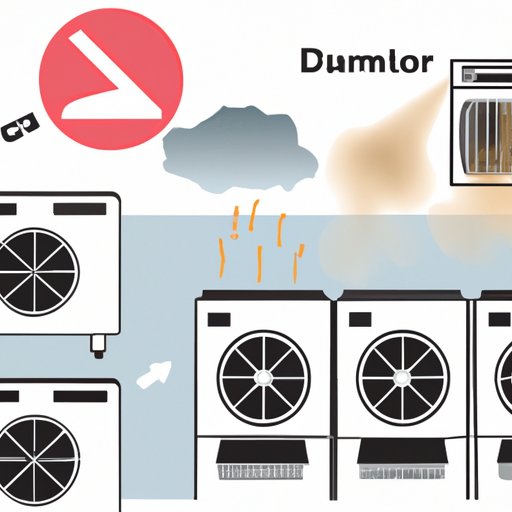Introduction
Condensation is a natural process of water vapor turning into liquid when it comes in contact with a cold surface. In the context of clothes dryers, condensation happens when the hot air produced by the dryer meets the cold surface of the drum or vent, causing the water vapor to condense. While condensation itself is not dangerous, the risks associated with it are serious and should be taken seriously.

Examining the Dangers of Condensation in Dryers
It is important to understand the potential dangers of condensation in dryers so that you can take steps to prevent it. Here are some of the most common risks associated with condensation in dryers:
Potential Health Risks
The most common health risk associated with condensation in dryers is the growth of mold and mildew. The damp environment caused by condensation provides the perfect environment for the growth of these organisms, which can cause respiratory issues and other health problems. In addition, if the condensation is left unchecked, it can lead to a buildup of lint and dust, which can trigger allergies and asthma attacks.
Fire Hazards
Another serious risk associated with condensation in dryers is the potential for a fire. The buildup of lint, dust, and other debris created by condensation can become combustible, increasing the risk of a fire breaking out. In addition, the presence of moisture in the dryer can cause electrical components to short circuit, creating a fire hazard.
How to Spot and Prevent Condensation in Your Dryer
Now that you know the risks associated with condensation in dryers, it is important to know how to spot and prevent it. Here are some signs to look out for and steps you can take to reduce the risk of condensation in your dryer:
Signs of Condensation
If you suspect that your dryer has condensation, there are several signs to look for. These include a musty smell coming from the dryer, visible mold or mildew, dampness on the walls or floor around the dryer, and a decrease in drying efficiency. If you notice any of these signs, it is important to take action right away.
Steps to Prevent Condensation
To reduce the risk of condensation in your dryer, there are several steps you can take. First, make sure to clean the lint trap after each use. This will help to reduce the amount of lint and dust buildup in the dryer. Additionally, make sure to keep the area around the dryer clean and free of clutter. Finally, have your dryer serviced regularly to ensure that all components are in working order.
What Causes Condensation in Dryers and How Can You Stop It?
In order to effectively prevent condensation in dryers, it is important to understand what causes it. Here are some of the most common reasons why condensation occurs in dryers:
Reasons Why Condensation Occurs
One of the most common causes of condensation in dryers is an improperly installed vent system. If the vent system is not properly installed, it can allow warm, moist air to escape back into the dryer, leading to condensation. Additionally, if the air filter is clogged or dirty, it can cause the dryer to become too hot, leading to condensation. Finally, if the dryer is overloaded, it can cause the appliance to overheat, resulting in condensation.
Solutions to Reducing or Eliminating Condensation
Once you have identified the cause of the condensation, there are several steps you can take to reduce or eliminate it. Make sure to check the vent system to ensure it is properly installed. Additionally, replace the air filter regularly and do not overload the dryer. Finally, make sure to clean the lint trap after each use to reduce the risk of lint and dust buildup.

Understanding the Risks of Condensation in Clothes Dryers
In addition to the potential health and fire risks, condensation in dryers can also cause damage to clothes and appliances. Here are some of the possible effects of condensation in clothes dryers:
Possible Effects on Clothes and Appliances
The presence of moisture in the dryer can cause clothes to become damp and wrinkled. In addition, the moisture can cause rust and corrosion on metal parts, leading to costly repairs. Finally, the moisture can cause electrical components to malfunction, leading to further damage.
Long-term Damage from Condensation
If condensation is left unchecked, it can lead to long-term damage. This includes the growth of mold and mildew, which can cause significant health problems. In addition, the moisture can cause structural damage to the dryer, leading to costly repairs or even replacement. Finally, the buildup of lint and dust can cause a fire hazard, putting you and your family at risk.
Conclusion
Condensation in dryers can be dangerous and should not be taken lightly. From health risks to fire hazards, the risks associated with condensation in dryers can be serious. To prevent condensation, it is important to understand what causes it and take steps to reduce or eliminate it. By taking the necessary steps to reduce the risk of condensation, you can keep your family safe and protect your clothes and appliances.


